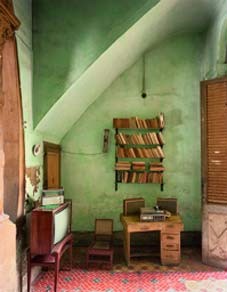Robert Polidori
dal 16/3/2006 al 25/6/2006
Segnalato da
16/3/2006
Robert Polidori
Martin Gropius Bau, Berlin
The historical context of a place, including its contradictions, is artist's subject. Many of his photos are devoid of any human presence. He is an architectural photographer despite himself. To him houses are animated monuments, thought up by people for people, and hence places that tell us something about people.

The Chernobyl disaster took place 20 years ago on 26 April 1986. The area, which contains the main towns of the region, Pripyat and Chernobyl, was declared indefinitely uninhabitable. In 2001 the Canadian photographer
Photographs
Robert Polidori ventured into the death zone. His pictures from that region form a highlight of the exhibition. The effect of each is like a still life of horror. They are intended, as one reviewer wrote, to serve as a warning to the “illiterates of the collective conscience"; they are a “plea for reason and responsibility".
Robert Polidori, born in Montreal in 1951, is not a photographer who specializes in catastrophes. He observes his objects soberly from a distance with the aim of finding the “emblematic moment" in which what was and what is congeal to form a single motif. The exhibition in the Martin-Gropius-Bau marks the European premiere of about 100 works, including photographs from Cuba, Lebanon, Versailles and New Orleans. It also shows some works from the series of architectural photographs taken for The New Yorker in recent years.
The historical context of a place, including its contradictions, is Polidori’s subject. Many of his photos are devoid of any human presence. Polidori is an architectural photographer despite himself. To him houses are animated monuments, thought up by people for people, and hence places that tell us something about people. Polidori sees himself as a photojournalist, an artist, a camera-toting sociologist, an anthropologist, and as a “muse of remembrance".
“When I point the camera at something", he explains, “it is like asking a question. And the resulting picture is the answer. It took me a long time to notice that the longer you look at a picture the more things you see that you did not notice at the first glance. The outcome is what you might call the knowledge dividend of a photograph."
He is self-taught as regards the technical aspects of photography. He rejects schools of photography because they teach everything about photographic equipment and cameras, but nothing about how to find the situations in which the equipment is needed.
Robert Polidori lives in New York and Paris. His photographs have been exhibited in Paris, Brasilia, New York, Los Angeles and Minneapolis. He works regularly for “The New Yorker", “Geo" and “Architectural Digest Deutschland". For his photo reports he travels the world in the role of cultural detective. On view for the first time are the pictures he took in New Orleans a few months ago for The New Yorker. His photographs of Versailles, Havana and Beirut are further highlights of the exhibition in the Martin-Gropius-Bau.
Press: Ute Weingarten, Katrin Mundorf, e-mail: presse@gropiusbau.de
Opening: 17 March 2006
Martin Gropius Bau
Niederkirchnerstr. 7 - Berlin
Hours: Wednesday to Monday | 10 - 20 hrs Tuesday closed



